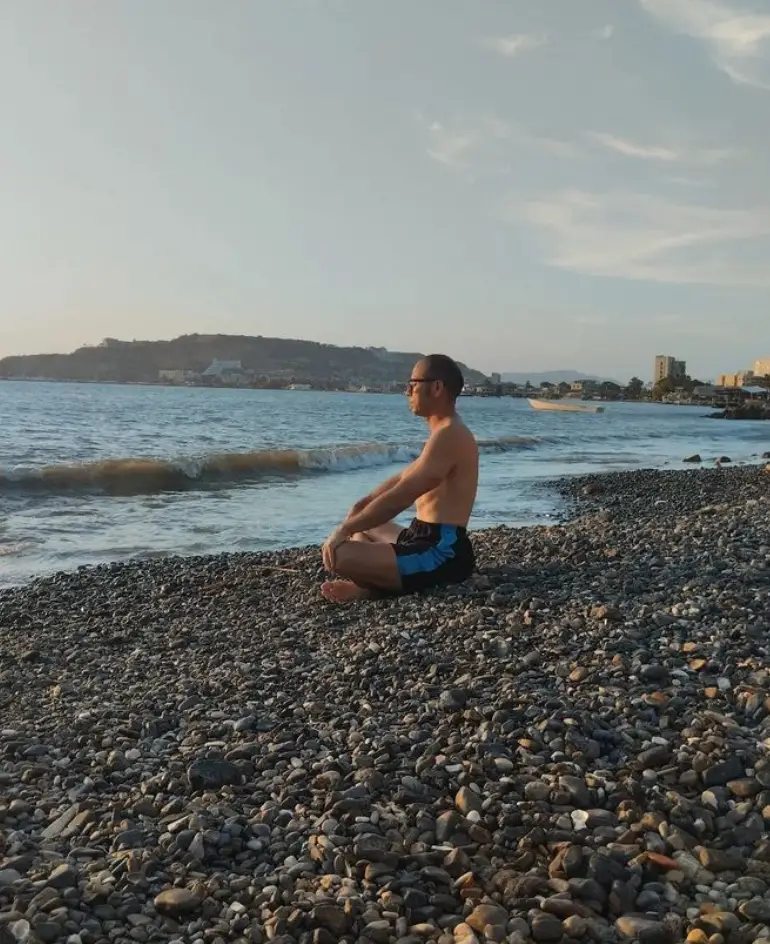“Atma Vichara” or more commonly known as self enquiry is a popular meditation practice involving self awareness. It requires you to reach self realization and enlightenment.
Practicing atma vichara can seem rather daunting, especially if you’re the type of person who gets easily distracted. But with repeated practice and primary focus on yourself, your consciousness will reach a whole new understanding of your own true nature and self.
The Atma Vichara meditative practice is usually the type that experienced practitioners go for. Being able to fully and easily concentrate on awareness and control your senses without any distractions takes years of training and practice. Let’s first see what self enquiry meditation is all about.

Origin and History of Atma Vichara
Self enquiry or atma vichara is a type of meditation that originated through Hindu scripts, namely the Bhagavad Gita from the ancient Advaita Vedanta tradition. This type of meditative practice was commonly performed only by Hindu sages and swamis to obtain self enlightenment and get answers to the difficult questions in life.
Who Brought Back Self Enquiry to the Modern World?
Although this practice dates back to 3000 BC, the Hindu sage Sri Ramana Maharshi reintroduced this practice in the 20th century and popularized it for any person who was willing to explore their true self and gain self knowledge and be able to answer questions about living beings.
What is Atma Vichara Practice, or Self Enquiry?

The term roots from Sanskrit where “atma” means “own” or “self”, and “vichara” means to “judge” or “know”. So ultimately, the words translate to “self knowledge”. Primary goals of this meditative practice are to be fully aware of your being and seeking the truth and insight through self inquiry.
Atma vichara helps the meditator or yogi to take themselves to the direct experience of self realization. Meaning, it is understanding that oneself is not just a single human being on earth, but that their real nature is one with the universe.
There are three key points to really understand for performing atma vichara:
- Ponder on the question “Who am I?”
- As thoughts arise, ask “Whose thoughts are these?”
- Once the feeling “I” provide clarity, ask “Where did this I come from?”
After you have figured out the answers to these key points, you can successfully practice atma vichara and manifest your being to be close to God.
How to Practice Atma Vichara (Self Inquiry) Meditation
The essence of atma vichara is to detach oneself from any external feeling or other thoughts, and to project pure consciousness atma all of your being. Here is how to get started with this meditation:
Step 1: Arrange calm surroundings
Like all other meditative practices, your setup needs to be peaceful and away from noise and chaos. Find a spot where no one can bother you, and make sure it is a quiet area.
Step 2: Settle down
Next, sit down in your regular meditative posture. But make sure to relax and ease your tensed muscles if you sense any.
Step 3: Initiate self awareness
Now is when you focus deeply as each thought arises in your mind. The tricky part here is that with each passing thought, you cannot associate a feeling to it. You must simply be aware of them, but refrain from getting carried away with them, or identifying them in any sort of way.
Step 4: Catch when thoughts arise
The consciousness of your brain will try to linger on any thought or idea that passes your mind. When the thoughts arise on their own accord and try to occupy your feelings, ask yourself who owns the thought and who is doing the thinking of it.
You are basically dissociated the thought from its subject and true nature by just identifying it as a thought only with nothing else connected to it. Continue this exercise with all the other thoughts that will arise during this process.
While you are doing this, there will come a self realization showing that all those thoughts are coming externally. As they are coming from outside, you are in control of what you do about them, which means you do not have to subject your consciousness on thinking about those.
Step 5: Ask, “Who Am I?”
Here is where you finally ask yourself – who am I? While asking yourself this, you will notice that you are not looking for a superficial answer which defines “I” as just your body, or current events, or your surroundings. Instead, the term “I” will manifest as a feeling.
However when you are focusing on the “I” you have to keep your mind strong and not let ego get in the way. Openly realizing the true nature of yourself and the significance of “Who am I?” will help you disregard the ego.
Step 6: Recognize and hold subject
This step is a continuation of the previous, where you continue to hold the feeling of “I”. As you gradually and finally get hold of yourself and realize that you are in fact the subject of meditation, you have to remain attentive to that feeling. The practice is to be be completely immersed in that moment, with your being, as only your presence matters.
Step 7: Reinforce your presence
While you identify the true nature of “I”, you will find that many different thoughts will come and go in your mind. Here is when you ask yourself – whose thoughts are these? There will be endless thoughts, but the one thing that remains constant is the presence of them through you, or “I” as you see it.
To put it simply, being able to answer whose thoughts those are is the next step in realizing your existence. You will start to feel that not only do you exist, but your presence transcends the universe and is the holder of all the thoughts.
Step 8: Ask, where has the “I” arisen from?
This step of the meditative practice is a bit challenging. Go deep into your mind, and ask yourself about the “I” you have just identified – where it has arisen from. The thought process for getting here may be a bit difficult and will require your own utmost attention.
You have to seek for this answer without asking yourself this question using words. Project your mind in a way that the questions just manifests itself within you, and your consciousness can feel it. In fact, you should not look for an exact and clear answer for this, but actually just unite yourself into the core of your own origin.
Step 9: Keep detaching
Even after following the 3 key points mentioned earlier, there will constantly be thoughts entering your mind. You have to detach yourself from them. For example, if you are in a class that you find boring, you are able to dissociate yourself from it and focus on something else.
Similarly, just purposefully remove yourself from any though that comes to your mind. But at the same time, you have to be aware that these certain thoughts arise, regardless.
Step 10: Focus and repeat
With so many thoughts entering and then consciously dissociating them, it is easy to let go and give in to those thoughts and feelings. That is why you need to keep repeating the steps so that your full attention is on the goal of the meditation and gaining self knowledge.
How Does Self Enquiry Lead to Self Knowledge?
The special thing about meditation is that it is not just an exercise of the mind, but of the body and mind as a whole. Same way it goes for the atma vichara meditative practice – it puts together the consciousness of your mind with the existence of your body to go deeper into your true self and gain wisdom and knowledge.
So, how does atma vichara actually help you gain a sense of self realization? The repeated practice of detaching yourself from the outside world and negative thoughts allows you to dissociate yourself from such things easily.
When you gain control over how you can just accept a thought coming in but without identifying or lingering on it, this gives your mind the power to block out all negative thoughts and energy. As a result, your mind and body gets trained to be fully aware of the consciousness that has be lying within you all along. This meditative practice helps you to bring out that consciousness and allows you to control it.
How to Improve Your Atma Vichara Practice

Self enquiry is no doubt an advanced type of meditation which requires extensive practice. It is also difficult for most people to practice as the concept circling it is rather abstract. However, it is not impossible and you should not give up even if you had several failed attempts.
Here are some things you can do to improve your atma vichara practice:
1. Be confident about yourself
If you are insecure in nature, you have to work on building self-esteem and loving yourself more. The core idea of atma vichara is the god like presence of yourself to which the entire meditative practice will center on. So it is highly important that you are confident about your being so that the self realization goes deep.
2. Be confident, but not cocky
While it is essential to understand and know the idea of who you are, you also cannot let your ego get in the way. Make yourself the subject while being humble at the same time, and disregard any feelings of superiority.
3. Practice yoga
While yoga and meditation are two different practices, they still go hand in hand and are definitely not mutually exclusive. Doing yoga can help train your mind better for thinking and concentration, at the same time help your body to sync with the mind.
If you are an expert yogi, you should definitely try Jnana yoga, which is known as the yoga of knowledge. This yoga technique itself focuses on self realization, which will help improve your associated meditation a great deal.
Another technique to try is Karma yoga, which is also based on the principles of self realization. With enough practice of both atma vichara meditation and associated yoga techniques, your self awareness can even manifest in deep sleep.
4. Continue practicing
As the base concept is complex and requires undivided attention during the process, atma vichara will get better only through continuous practice. The more you practice, the easier the answers will come to you, and you will feel the self realization just coming to you naturally with minimal effort. You just need to be patient and give it enough time.
Final Words
Although originated from sacred Hindu texts, the atma vichara meditation can be performed by anyone if given enough time and practice. The key to self enquiry and getting answers is to genuinely understand and feel the true nature of one’s one self and their own thoughts, and seek the truth from within by manifesting oneself as a presence.
Not only does atma vichara help you realize your existence, but it also shows you the truth of God and all things divine. With a lot of practice and yoga to go along with it, it is possible to successfully perform atma vichara meditation to gain self knowledge and wisdom.
